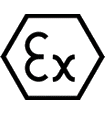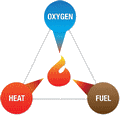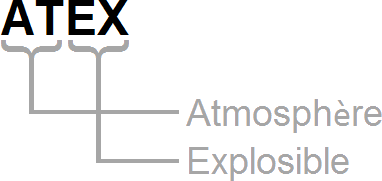
 |
What is ATEX |
 |
The name ATEX comes from the French..
ATmosphere EXplosibles
The ATEX regulation is a European directive which requires all heads of organizations to fully understand the risks related to certain explosive environments. To do this, an evaluation of the risk of explosion in a company is required in order to identify any locations where explosive environments could form, and then to put in place the means to avoid explosion.

HOW DO YOU CHOOSE EQUIPMENT THAT IS ADAPTED FOR AN ENVIRONMENT AT RISK OF EXPLOSION...
ATEX environments are subdivided into three zones..
• zones 0, 1 or 2 for gases
• zones 20, 21 or 22 for dust
There are two groups of materials..
• group I.. concerns mines (more restrictive)
• group II.. concerns all above-ground industries
For Group II (above-ground industries), a specifically adapted category of equipment is associated with each ATEX zone classification.
| Zone classification | ATEX classification required for equipment (for Group II, above-ground industry) |
| Zone 0 (gas) Zone 20 (dust) PERMANENT RISK |
Category 1 VERY HIGH LEVEL OF PROTECTION |
| The explosive mix is present constantly or for a long period of time | |
| Zone 1 (gas) Zone 21 (dust) FREQUENT RISK |
Category 2 HIGH LEVEL OF PROTECTION |
| An explosive mix may form under normal working conditions. | |
| Zone 2 (gas) Zone 22 (dust) OCCASIONAL RISK |
Category 3 NORMAL LEVEL OF PROTECTION |
| An explosive mix has a small chance of forming and would exist only for a short period. | |
WHAT DOES THE MARKING MEAN...
All products designed for use in explosive zones have a specific marking on them. This marking contains all the information necessary to determine the zones in which the product may be used.
Example of marking..
CE 0081 ![]() II 2 GD Ex nAnL IIB T4
II 2 GD Ex nAnL IIB T4
- CE.. the equipment meets European standards for this product
- 0081.. identification number of the notified body, when it intervenes in the inspection phase of production Here the number corresponds to the LCIE - Bureau Véritas. This number may also be 0080, for example for INERIS.
 .. Use authorized for explosive environments
.. Use authorized for explosive environments- II.. equipment group
I - mines,
II - above-ground industry
- 2.. category of equipment
1 - permanent risk (zones 0/20),
2 - frequent risk (zones 1/21),
3 - occasional risk (zones 2/22)
- GD.. type of fuel source G = gases and vapors, D = dust
- Ex.. the product meets the Cenelec protection standards
- nAnL.. type of protection
- IIB.. indicates the class of gases covered by the product
- T4.. temperature class corresponding to a surface temperature